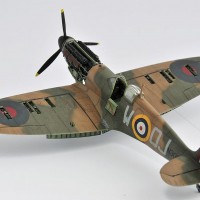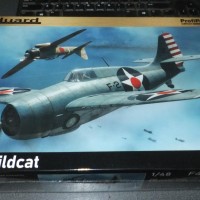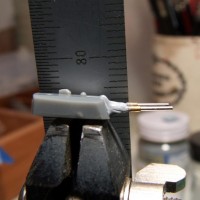Review: 1/48 Academy F-86F "Paper Tiger"
The Airplane:
The F-86F was developed as a result of the combat experience over Korea against the MiG-15, which had shown that the F-86A and F-86E were outperformed by the Soviet fighter at high altitude. Appearing in Korea in the summer of 1952, the F-86F was eventually equipped with the “6-3 hard winng,” which extended the leading edge six inches at the fuselage and three inches at the tip, with the leading edge slats replaced by a “hard” leading edge. While this increased the landing speed of the Sabre, the change resulted in the Sabre's flight ceiling being increased to 52,000 feet - superior to the MiG-15's 51,000 feet - while including a higher climb rate, improved turning circle and a ten-knot increase in top speed over the F-86E. The all-flying tail, first installed on the F-86E meant that the F-86F could go supersonic in the dive fairly easily, unlike the MiG-15 which was solidly sub-sonic due to the position of its fixed stabilizer. With the “6-3" wing, the F-86F was superior to the MiG-15 in all flight conditions. The first “hard-wing” missions were flown by the 51st FIW in August 1952.
Captain Harold E. Fischer, Jr.
Born near Lone Rock, Iowa in a farm on May 8, 1925, Hal Fischer grew up reading about the flyers of the First World War and building model airplanes he flew from the roof of his family's barn. He joined the Navy briefly before the end of the Second World War, then joined the Army in 1948 after attending Iowa State University for two years. In 1950, he transferred to the Air Force and went through flight training at Williams AFB in Arizona.
Fischer was then sent to Korea to fly with the 49th Fighter Wing, then equipped with the F-80C Shooting Star, flying fighter-bomber missions. Following his tour, he went to Fifth Air Force HQ as staff officer in the Combat Crew Branch. He met 51st Fighter Wing ace Major Bill Whisner, commander of the 25th Fighter Squadron, who was on leave in Japan, and decided after listening to Whisner's stories about MiG Alley air battles that he would volunteer for a second tour. He went to Korea where he recalled, “I made several visits to ‘court' the F-86 units there. This paid off, and soon I received orders to the 51st Fighter Interceptor Wing at Suwon.” Fischer was assigned to the 39th FIS, which had just been attached to the 51st Wing. After 6.5 hours of checkout in the F-86E, he was cleared for combat missions.
Fischer scored his first victory on his fifth mission. “Just as I was going to break off the attack, the MiG wingman began a slow descent. I called the flight leader and said I had one going down. I followed the MiG, and when I caught up to him, I rolled around him and got one of the biggest surprises of my life. The canopy was missing and the pilot was gone! When the MIG crashed I knew that there was no positive verification on the gun camera film, so I strafed the wreckage for confirmation purposes.”
Hal Fischer became the 25th U.S. jet ace of the Korean War on 24 January 1953 in his F-86F-10NA, 51-12958, which he had named “Paper Tiger” in reply to the Chinese Communist assertion that the United States was an over-rated “paper tiger.”
Fischer's fifth victory stood out in memory for the rest of his life. “The fifth kill was one of both anguish and jubilation. I ended up in a tail chase about 4000 feet from the MiG. Again, I turned off the radar computing gunsight, elevated the nose and fired. The tracers made a small halo around the MiG. Gradually a fire began to grow in the rear of the MiG, and about the time I had closed to an ideal firing range there was no need to expend any more ammunition. It was a dying aircraft, with the entire fuselage serving as a flame holder.
“I pulled up alongside. the pilot was beating on the canopy, trying to escape. Seeing me, he tried to turn and ram me. I thought the humane thing to do was to put the pilot out of his misery, so I slid my Sabre back onto his tail. Molten metal from the MiG rained on my aircraft. Firing a few short bursts, the sounds suddenly changed, three of my guns quit firing, my left rudder pedal went to the firewall, and I thought for sure I had been hit. I disengaged and cautiously returned home to find after landing that the intense heat from the burning MiG had caused a misfire of a .50 cal. round. The exploding cartridge shut down the guns, severed the rudder cable, and subsequently dumped my pressurization.”
On 6 April 1953, Fischer scored his tenth victory to become a double ace. His final mission was the next day, 7 April 1953. As he recalled, “My last mission of the war was both successful and unsuccessful. I set up a pass on two MiGs in formation. My speed was such that I rolled over the number two man and fired a long burst that stopped his engine. Devoting my attention to the leader, I fired from about 1200 feet and this tore apart the MiG. Debris came back at my aircraft in large pieces. I instinctively ducked as parts came by my canopy. Some of them went into my engine and it came to a stop. I smelled smoke and stepped over the side and into captivity.”
In reality, Fischer had been shot down by Lieutenant Han Decai of the Chinese People's Liberation Air Force, who hit him at the same time he hit the wreckage of his twelfth victim. Fischer has also been claimed as a victory by Major Dimitri Yermakov, a WWII ace with 26 victories, who claimed Fischer's F-86 as one of two he was credited with in the Korean War. Following the end of the Cold War, Fischer corresponded with Yermakov and met then-General Decai during a visit to Shanghai in 1997, where he presented his former opponent with a model of “Paper Tiger.”
Fischer had touched down on the wrong side of the Yalu River, and his captivity lasted for over two years, past the end of the Korean War on 30 July 1953. After a thwarted escape attempt nine months into his captivity, he was routinely tortured and ultimately admitted to trumped up charges that he had been ordered to enter Manchuria and that he had participated in germ warfare. After a short mock trial in Beijing on May 24, 1955, Captain Fischer and the other pilots — Lt. Col. Edwin L. Heller, 1st Lt. Lyle W. Cameron and 1st Lt. Roland W. Parks — were found guilty of violating Chinese territory by flying across the border while on missions over North Korea and were sentenced to be deported. The four pilots crossed Freedom Bridge at Panmunjom and returned to South Korea the next day.
Fischer served on active duty until 1980, flying 200 missions in Vietnam as a helicopter pilot. He died 24 May 2009 from complications to back surgery. I had the privilege of meeting this soft-spoken ace at the 1984 AFAA Convention.
The Kit:
Academy's 1/48 F-86F-30 Sabre came out a few years after the release of a 1/48 Sabre by Hasegawa. The two kits are somewhat similar, but the Hasegawa kit is generally considered more fine in detail and to fit better.
I picked up this kit from an estate sale at the local hobby shop last summer, when I found it at a price I couldn't say “no” to.
I had it assembled for painting by late summer, then got involved with more house cleanup and then a catch-up campaign to finish off the coming book, “the Tide Turns.” The result was the model was forgotten until I opened the box last month. Thus it became the second all-NMF model I did with the new Super Metallics paint.
Construction:
After assembling the wing and setting it aside, I turned to the fuselage. I had painted the cockpit black and assembled it per the kit's instructions with the intake trunking. The kit cockpit is not as good as that in the Hasegawa kit (both do better with the True Details resin cockpit and seat, though since KW Sabres all had black cockpits, the seat is the one thing really needed). I took a look at the pilot figure and found it to be pretty good, with a nicely-molded G-suit and flying jacket, so I decided I would stick the pilot in the cockpit to hide the lack of detail. I painted him per the figure paintings in Osprey's “Korean War Aces.” I found that the seat was just a bit too tall to allow the canopy to be positioned closed, so cut it down a bit to allow assembly with the canopy closed.
Fit overall is not as good as the Hasegawa kit, and after I attached the fuselage sub-assembly to the wing sub-assembly I found I needed Mr. Surfacer 500 on all the joints and seams. I cleaned these up with several different-grit sanding sticks and then polished the model to get rid of any small scratches, since I was going to apply a natural metal finish.
Painting:
This model was painted with the new Mr Hobby Super Metallic paints and the new Tamiya lacquer base metallics.
The overall airframe was painted with SM-208 “Super Duralumin.” I then used Drafting Tap (very low-tack) to mask off the wing center sections and paint that with Tamiya LP-70 “Gloss Aluminum” thinned 40-60 to bring down the high gloss to semi-gloss. The nose cap was painted with Mr Hobby SM-201 “Super Fine Silver”. The tail cone was painted with Tamiya LP-72 “Mica Silver”. The gun panel was done with Mr Hobby SM-203 “Super Iron.” The gun bay panel was done with Tamiya LP-11 “Silver”. All thse were thinned 50-50 with Mr Color Leveling Thinner 400.
Decals:
I used the fuselage ID stripe and wing stripe decals from the Micro-Scale sheet 48-812, which I also used to do the markings of Hal Fischer's “Paper Tiger.” I used the kit decals for the extensive stenciling.
Final Assembly:
I attached the landing gear with the air brake doors fully open.
Overall:
Neither the Academy Sabre nor the Hasegawa Sabre are currently in production. The Academy kit can be found for cheaper prices than the Hasegawa kit, but it's a case of “you get what you pay for.” You will put more work into the Academy kit to get a final result that to me isn't as good as the Hasegawa kit. But the Academy kit is more commonly available nowadays, so there's that. The end result looks good, and I can recommend the kit for anyone who likes the F-86.
Thank goodness, Clear Prop has announced they like making a lot of money, and will release an F-86A with slatted wings later this summer!















Nice result! Interested in your shift from Vallejo metallics to these new paints... any comparisons you can share?
The Vallejo metallics are good, and if you have to deal with not having any "smell" to your modeling (which I used to), they are recommended as the best. If you don't have the smell problem to deal with, the Supermetalics are mostly just "better." You don't have to apply them over a primer, they are more sturdy after application (they don't rub off) and they look more like "metal" than any other I have found.
Excellent job, ditto article and great info on the Super Metallics, Tom!
Sharp Sabre. Looks like you are getting some "practice" before the Clear Prop A shows up.
Yes!
Great work Tom! Hadn’t heard about the Tamiya metallics. I’ll check them out!
The main ones are the Mr Hobby Super Metallics
Nice work, Tom. Do you know how the Super Metallics perform over small spots of Tamiya putty or Mr. Surfacer?
@j-healy - They go on over anything.
A fine looking Sabre, Tom @tcinla
I do clearly recognize your experience on this Academy kit, nevertheless it is still a nice kit to work on.
Gorgeous scheme, bet that was quite tricky, though with all the decals and the nmf colors. Those Sabres just look fine when they're that 1950ies shiny! 🙂